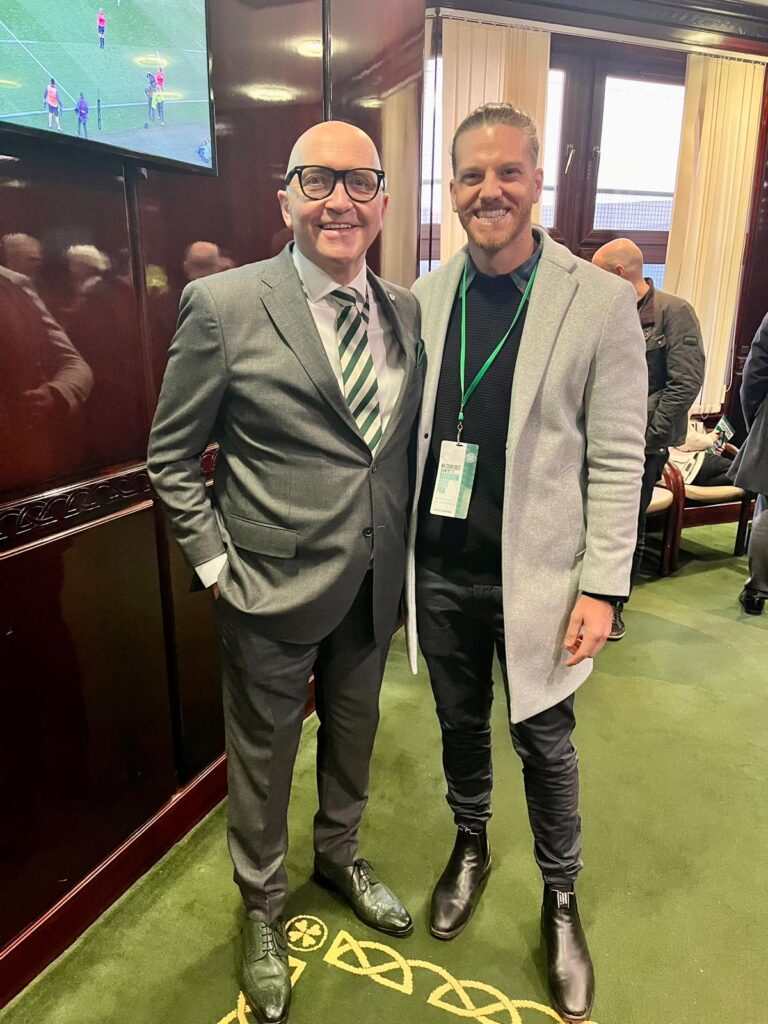I climbed the stairs from the Boardroom into the 60,000 strong stadium. The rain was falling, adding to the tense atmosphere. The chants from the fans became louder and clearer with every step. The stadium lights produced a mesmerising glow on the pitch. It was a somewhat surreal moment, I felt like I was a part of something bigger. Something that brought people together. There was an unmistakable sense of camaraderie as everyone stood united in their passion for the game, the love of their team, and the pride in their community. It was a truly memorable moment that reinforced the immense power of sport.
When I reached out to Tony Hamilton, the CEO of Celtic FC Foundation, a month earlier, I had no idea about the rich history of the club or that I would be granted access to their inner sanctum. Within minutes of arriving at Celtic Park, it was very clear that this was no ordinary club. This was a club that had a deep commitment to the community. And It certainly didn’t take long for Celtic FC to recruit yet another fan.
Building a Strong Foundation
The day kicked off with a short walk from central Glasgow to Celtic Park. It was obvious that it was a game day in Glasgow by the excitement and energy in the city. The streets were full of fans wearing green and white, hopping from pub to pub, and chanting as part of their typical pre-match routine. Shortly after, we reached the main entrance of Celtic Park and were immediately captivated by the massive banner of Brother Walfrid that welcomed us.
“A football club will be formed for the maintenance of dinner tables for the children and the unemployed” – Brother Walfrid
Celtic FC is a football club with a deep sense of purpose and a long history of charitable work. The club was founded by Brother Walfrid in 1887 with the aim of raising funds to help alleviate poverty in the East End of Glasgow. This mission has remained at the heart of the club’s ethos ever since.
Established in 2013, the Celtic FC Foundation aims to harness the power of football to make a positive difference in the lives of people in need. Celtic FC’s clear understanding of their purpose is one of the key reasons they have been so successful. From the very beginning, the club has been committed to promoting positive health outcomes and supporting those most vulnerable within their community.
For sports foundations, knowing your “why” is essential. It’s what drives your organisation, motivates your team, and inspires your community. Without a clear purpose, it can be difficult to create meaningful impact or attract the support necessary to sustain your work. For Celtic FC, the ‘why’ is on display everywhere you look. It’s the major sponsor who donates corporate hospitality to support juvenile rehabilitation. It’s in the Green Brigade who dance and sing with banners that promote inclusion. It’s in the Foundation CEO who sacrifices his time to share his knowledge and experience with someone he’s only exchanged a few emails with. This club lives by, and demonstrates its mission in everything it does.

The Hidden Costs Of High Turnover
As we stepped into Celtic Park, we were greeted with a warm Scottish welcome that set the tone for the rest of our journey. Our first stop was the administration office located in the back of the stadium, where Tony shared an in-depth history of the club and foundation. His infectious passion for the club and its mission had us hooked from the get-go.
Our next stop was The Celtic Learning Centre, where we were introduced to the club’s commitment to engaging and supporting the community. As we continued our tour through the corridors of Celtic Park, it became increasingly evident that Tony was the embodiment of the club’s mission. He greeted every single member of staff, from security to game day operations, by name, a testament to his 20 years of dedicated service to the club. Tony is undoubtedly the heart of the foundation, and his unwavering commitment to the cause highlighted the critical importance of staff retention for foundations.
The high turnover rates in the Australian sports industry are well-known, with staff constantly coming and going. While this is not uncommon in many industries, it can be particularly challenging for sports foundations. Unfortunately, sports foundations are often one of the business units that suffer the most from this high turnover. Typically operating with a lean roster (sometimes just a one man band), when an employee leaves, a huge void is left behind.
Fundraising is a unique skill set, and each organisation, foundation, or charity has its own identity that must be understood. Understanding and translating a foundation’s purpose to potential donors is key for successful fundraising. Donors need to be clear on where their money is going and what impact it will have. Building and maintaining the donor relationship takes time, and constant staff turnover can make this task challenging. Donors may become frustrated and question the organisation’s culture if there is a revolving door of staff.
Good Governance Keeps You Focused On What Matters
After visiting the Celtic Learning Centre, we headed to The Lions’ View Sensory Room, a heart-warming space designed for children and young people with sensory, auditory, or visual disorders. The moment we stepped inside, we could feel the love and care that went into its creation. The room’s soundproofing and interactive toys created a calming environment that truly felt like a home away from home. And of course, some of the best seats in the stadium to witness (hopefully) another Celtic FC victory. It was an inspiring reminder of the impact that sports foundations can have on their communities. And, if you want to learn more about The Lions’ View Sensory Room or contribute to its mission, you can click here.
We then called into a private suite, where we had the privilege of meeting young adults involved in the Gateway to Employment project. The club, using the power of sport to help individuals who are at risk of offending or reoffending, or who come from an area with a high risk of crime, turn their lives around. The room was buzzing with energy and excitement for having the opportunity to cheer on the team they love in some of the most premium seats in the entire stadium. They were also pretty wrapped to meet a couple of Australians. To find out more about the club’s Gateway to Employment program, click here.
Once we finished our tour of Celtic Park and learning about the club’s commitment to the community, we were lucky to have the opportunity to enjoy the rest of the game day experience in the Boardroom. Throughout the day we enjoyed meeting and chatting with several key stakeholders, including donors, sponsors, and board members. These conversations provided a deeper understanding of the foundation. And It became clear that Celtic FC’s holistic approach to community engagement, fundraising, and governance has contributed significantly to their success. It also reinforced the importance of strong governance in the success of any foundation.
Foundations can easily become side-tracked by the latest trends and ideas in today’s fast-paced environment. They risk suffering “shiny object syndrome” if good governance is not in place. In this context, good governance refers to the rules, procedures, and processes that direct and regulate a foundation. It encompasses decision-making, accountability, and transparency.
Given the complex funding mix, foundations can be tempted to pursue funding streams that don’t align with their core purpose to maintain financial stability. In recent times, we have also seen foundations used as a branding exercise, rather than staying true to their core purpose. This can impact donor trust in the foundation’s ability to make a real difference in people’s lives. To avoid shiny object syndrome and stay true to their core purpose, foundations must establish clear goals and objectives, create a robust framework for decision-making, and ensure transparency and accountability in all aspects of their work.
Celtic FC Foundation is a great example of a well-managed organisation that through good governance operates with complete confidence and transparency. The foundation’s leadership are committed to achieving their objectives and upholding the club’s values. This has contributed to a culture of excellence and success. This in turn has created loyalty among fans, donors and the wider community. You can read more on governance for sports organisations here.
Winning On And Off The Field
Celtic FC went into the match as short priced favourites. But at half time, down 0 – 1 we were staring down the barrel of never being allowed back at Celtic Park. Fortunately, the Ange Postecoglou coached side (up the Aussies!) put on a masterclass in the second half to come away with the victory.
As we walked away from Celtic Park that day, it wasn’t just the win that we left with. I couldn’t hide the sense of inspiration I felt. Celtic FC’s commitment to its community and the impact it has made on people’s lives is special. The foundation’s success lies in its clear understanding of its purpose and the dedicated staff who embody its mission. It’s clear that Celtic FC has built a strong foundation, and it’s a model that sports foundations can learn from and emulate. Now, if YOU need help building your foundation, so that it has a clear understanding of it’s purpose, check out our sport philanthropy strategy services here.


